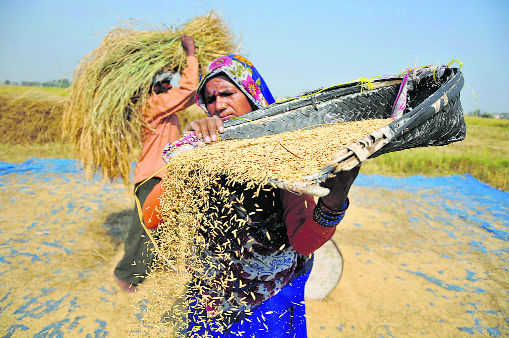
Ray of hope: Agriculture, which employs over 50 per cent of the population, has the ability to reboot Indian economy.
Devinder Sharma
Food & agriculture specialist
IN March 2018, an estimated 2.5 crore people, more than the population of Australia, applied for about 90,000 positions in the Indian Railways. In 2015, over 23 lakh candidates, including 22 lakh engineers and 255 PhD holders, had applied for 368 posts of peon in the Uttar Pradesh state secretariat. As many as 7,000 people, most of them college graduates, applied for 13 vacancies for waiters in Maharashtra’s secretariat. Undoubtedly, the job scenario across the country is appalling.
This is borne by the fact that India’s unemployment rate rose to a 45-year high during 2017-18, as a newspaper reported, quoting the National Sample Survey Office (NSSO) study conducted between July 2017 and June 2018. At a time when India’s economy has been on a growth trajectory in the past four years - growing at an average exceeding 7 per cent per annum — the failure to provide jobs to millions of people is a clear-cut pointer that relying on a higher GDP is not the answer to creating more jobs. Whether we like it or not, it is now becoming apparent that a higher GDP does not translate into more employment opportunities.
Although Finance Minister Arun Jaitley dismisses the study, saying “if the economy is growing at 12 per cent nominal growth in the past five years, it would be an economic absurdity to say that such a large growth, the highest in the world, doesn’t lead to the creation of jobs,” but the question that needs to be asked is: where are the jobs? While all-out efforts are being made to show that job creation is on track, a report by the Centre for Monitoring of Indian Economy (CMIE) deflates the claims when it shows that in the past year, almost 1.1 crore people lost their jobs. “An estimated 91 lakh jobs were lost in rural India, while the loss in urban India was 18 lakh jobs. Rural India accounts for two-thirds of India’s population, but it accounted for 84 per cent of the job losses,” the report said.
Growth without jobs is meaningless. The indication that a higher GDP does not automatically lead to more jobs was clearly visible in the UPA era when despite a high growth exceeding 8.3 per cent on an average, only 1.5 crore jobs were created in 10 years (2004 to 2014). This was against the annual intake of about 1.2 crore fresh entrants in the job market every year, which meant that against the need to provide 12 crore people with employment, the UPA government could provide only 1.5 crore jobs. Ten years is not a small period, and it is here that policy-makers failed to realise the inability of economic growth to create more jobs.
Still worse, a Planning Commission report had worked out that between 2004-05 and 2011-12 , about 14 crore jobs were lost in agriculture. Many economists term the migration from agriculture to be a welcome sign. Going by the World Bank prescription, which was doled out back in 1996, India was directed to go for a population shift, translocating 40 crore people from rural to urban areas in the next 20 years, by 2015. While most government economists have blindly followed the World Bank prescription, I have always termed these 40 crore people being forced to migrate from the villages as ‘agricultural refugees’. In the absence of alternative employment opportunities, these millions are swarming into the cities looking for menial jobs. Without any definite strategy to employ them, no one knows what they will do in the urban centres. If the objective is to move people out of agriculture simply to meet the growing needs of cheaper labour for infrastructure, industry and real estate, in other words to provide for dehari mazdoor (daily wager), there is something terribly wrong with the way dominant economic thinking is perceived. The general understanding is that those moving out of agriculture will be automatically absorbed by the manufacturing sector. It was primarily for this consideration that the National Skill Development Policy aimed at reducing the population involved in agriculture from 52 per cent to 38 per cent by 2022. But the reality is that during the period, agriculture saw an unprecedented rate of migration; manufacturing, too, slumped, causing a loss of 5.3 crore jobs. More recently, another 1.06 crore jobs were lost in the manufacturing sector during the four-year period (2011-12 to 2015-16).
Since agriculture is the biggest employer, employing 52 per cent of the population as per the 2011 Census, the resolution of the monumental employment crisis that India faces actually lies in the crop fields. If only agriculture can be turned economically viable and ecologically sustainable, it can easily take away much of the pressure the country faces in creating additional employment. All it requires is a paradigm shift in economic thinking, which begins by first treating agriculture as an economic activity, which has multi-faceted roles cut out. Making farm livelihoods economically sustainable should be the first step towards achieving the objective of ensuring gainful employment for marginalised communities. Once agriculture becomes economically viable, providing more income to 60 crore people, it will reignite the rural-based industry, and in the process trigger a reverse migration.
Whether we like it or not, only agriculture has the ability to reboot the economy. The increased demand a refurbished agriculture will create will be phenomenal, leading to a spurt in industrial production. This may not be there in the economic textbooks, which still emphasise on reducing the population in farming, but it is time to look beyond. If the Constitution can be amended umpteen times, I see no reason why dominant economic thinking cannot undergo a transformation for the better, in tune with the changing times. It’s time to accept that agriculture is truly the mainstay of Indian economy.



























